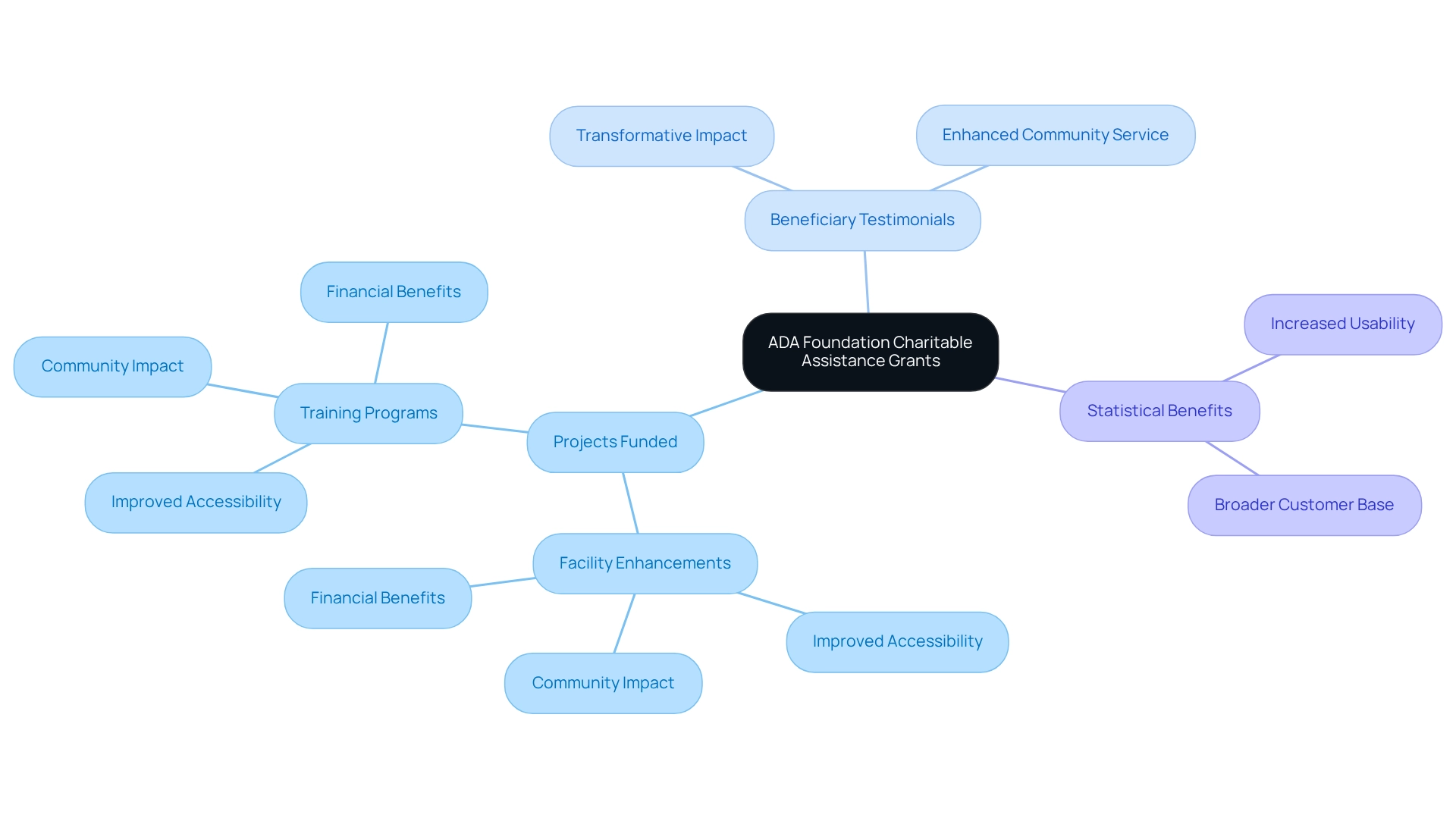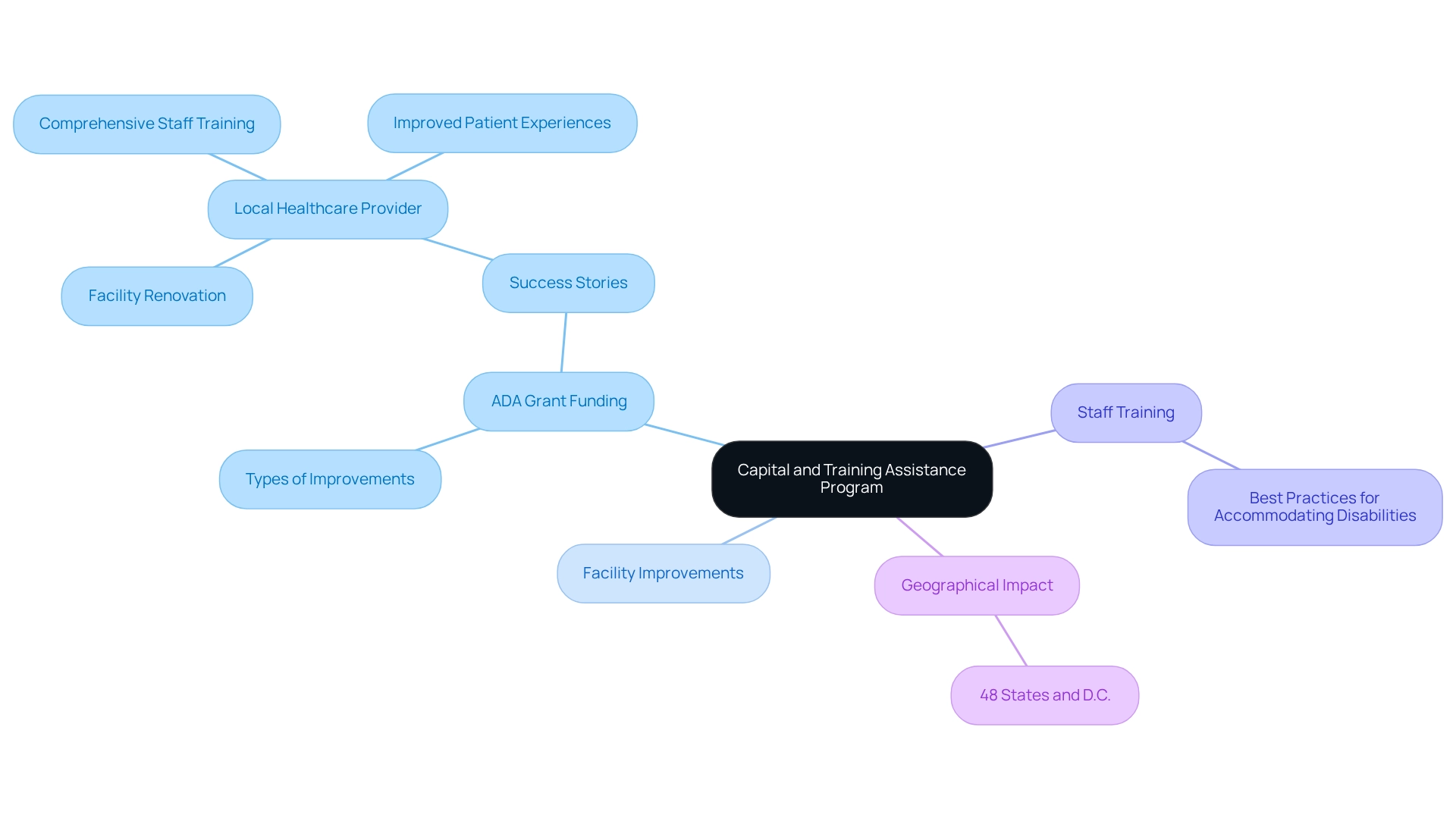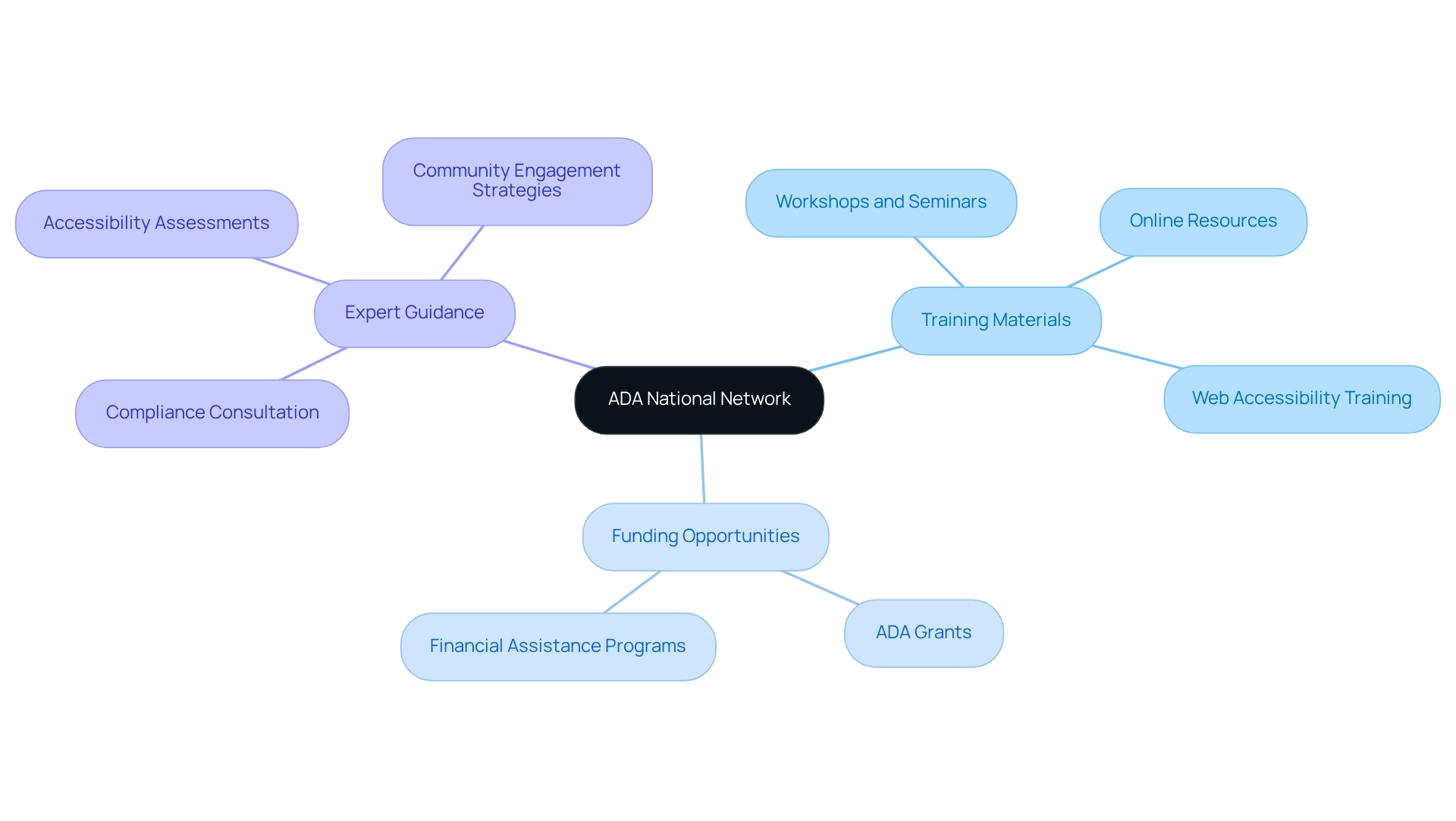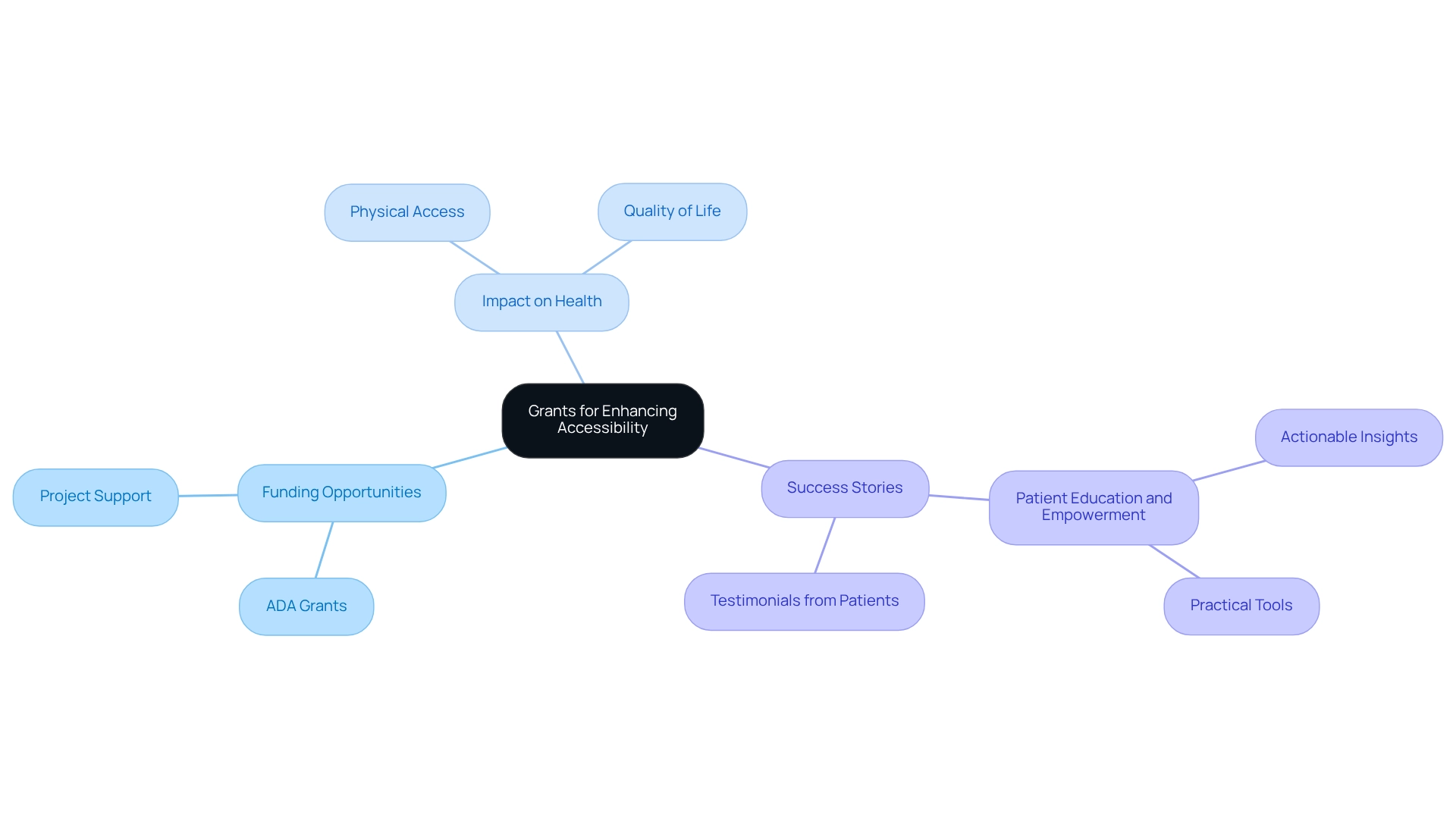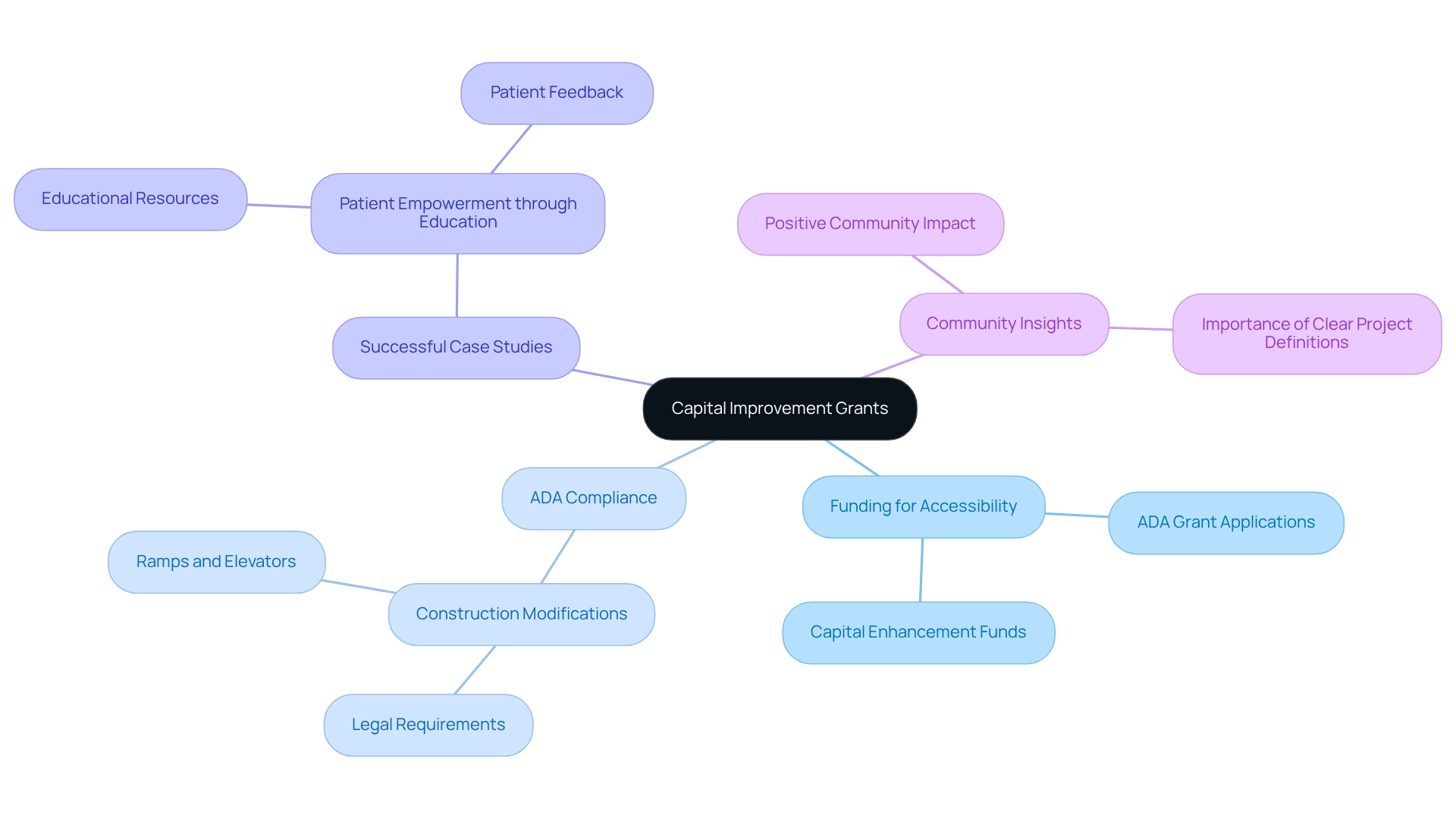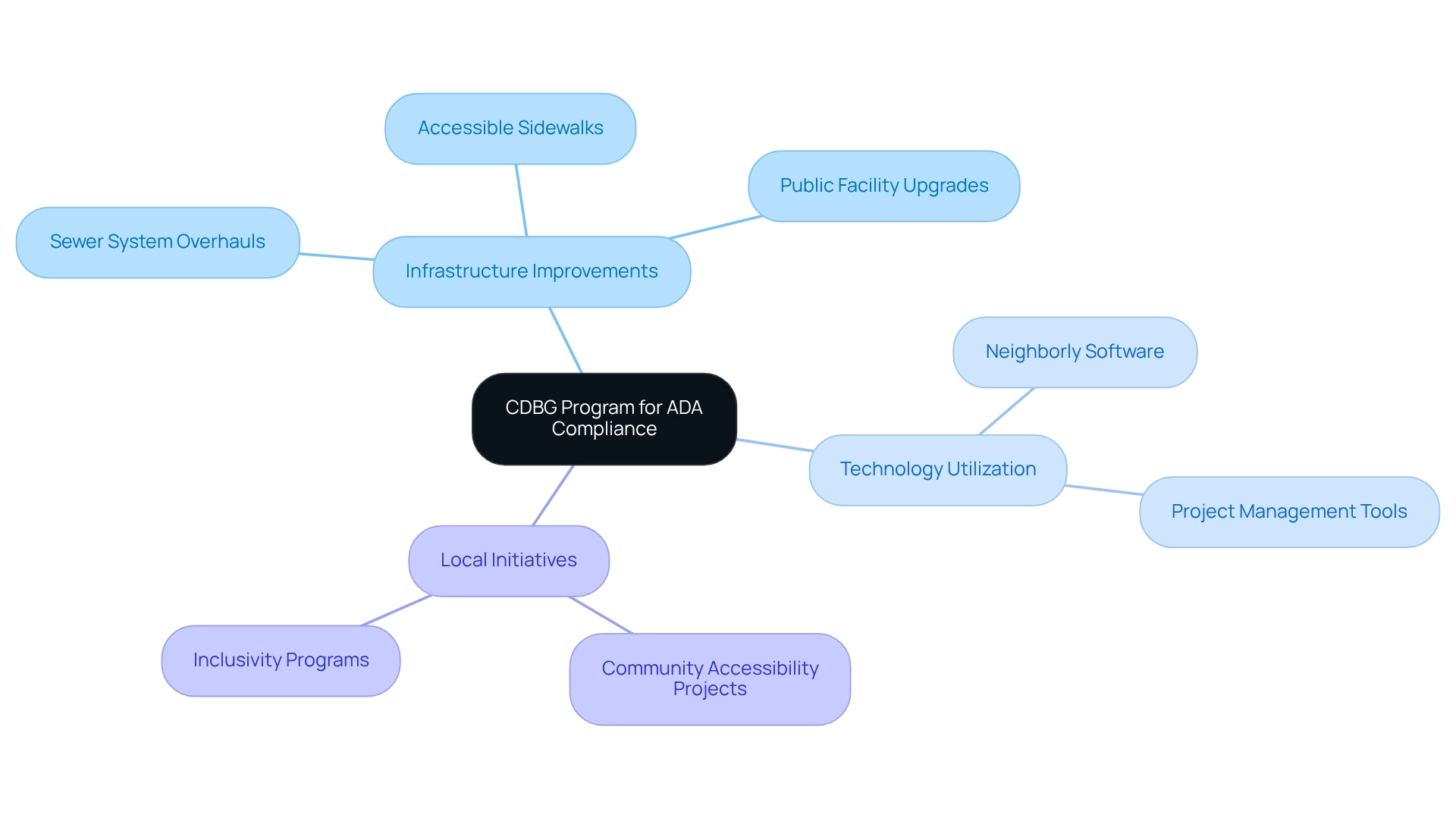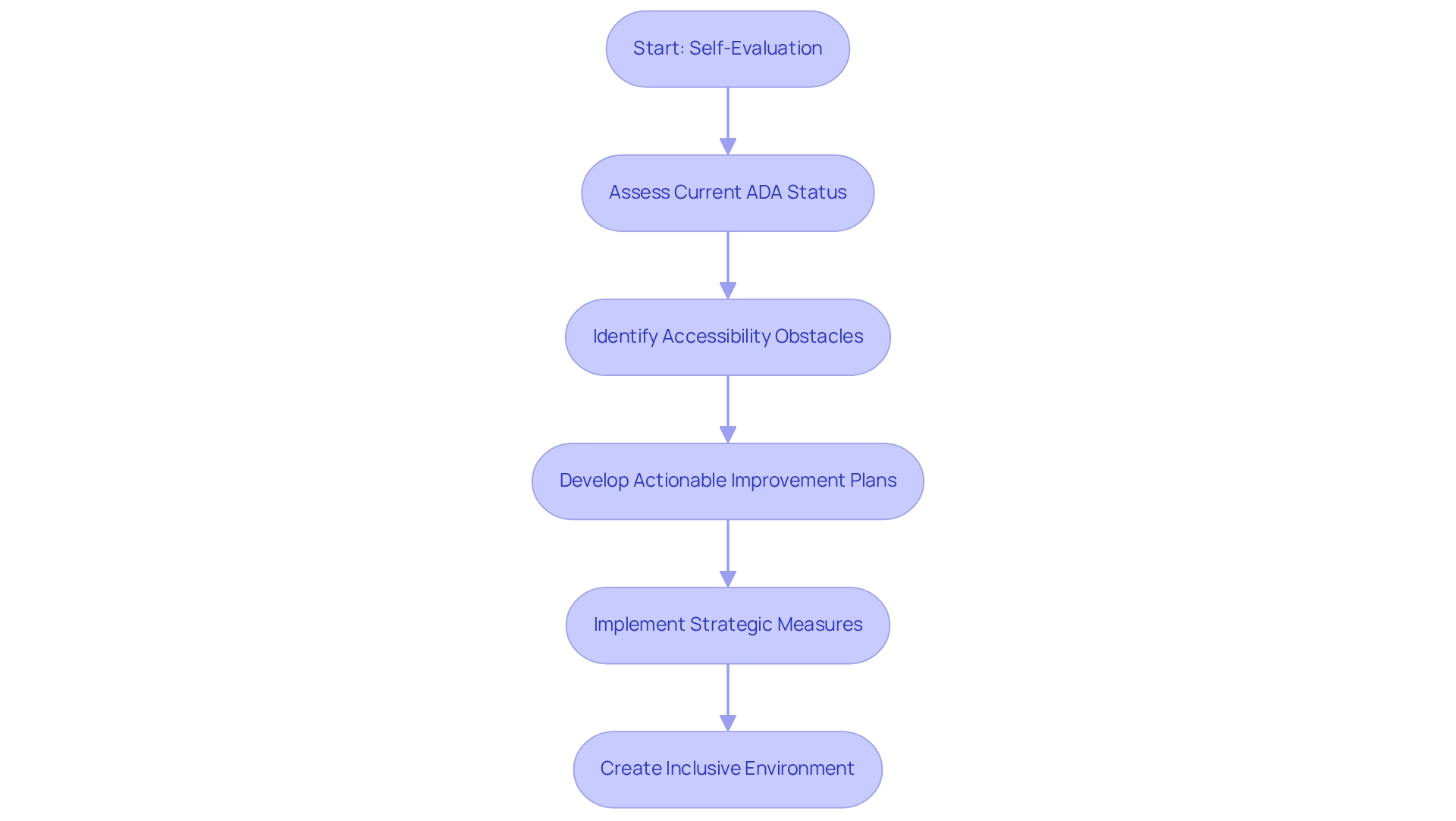Overview
This article emphasizes the vital resources available for enhancing accessibility through ADA grants. It acknowledges the challenges faced by organizations and municipalities in meeting ADA standards. By highlighting various programs and funding opportunities, it offers support to those striving to foster inclusivity. Ultimately, these resources aim to improve the quality of care and access for individuals with disabilities, creating a more welcoming environment for all.
It’s important to recognize that embracing these opportunities not only aids compliance but also enriches the lives of those who benefit from enhanced accessibility.
Introduction
In our increasingly inclusive society, it’s vital to recognize the significance of accessibility. Many organizations across various sectors are becoming aware of the essential role they play in ensuring that individuals with disabilities can access services and facilities equally. From integrative wellness centers to municipal programs, there is a wealth of resources and funding opportunities available to support compliance with the Americans with Disabilities Act (ADA).
This article explores the various initiatives aimed at enhancing accessibility, shining a light on the transformative impact these efforts have on communities, individuals, and organizations alike. By examining grants, training programs, and compliance resources, it becomes clear that fostering an inclusive environment is not merely a legal obligation; it’s a pathway to improved quality of life for everyone.
It’s important to understand that these initiatives can make a significant difference. When we come together to support accessibility, we are nurturing a community where everyone feels valued and included.
Integrative Wellness Center: ADA Compliance Support and Resources
Integrative wellness centers play a vital role in promoting inclusivity by offering essential resources and support that align with ADA grant standards. These centers provide comprehensive training for staff, ensuring they are well-versed in the latest regulations and best practices for creating welcoming environments. By implementing effective facility modifications, they set a benchmark for accessibility in healthcare, ensuring that all patients, including those with disabilities, receive the equitable care and support they deserve.
It’s important to recognize that successful ADA adherence initiatives within these centers demonstrate the positive impact of such training on staff performance and patient satisfaction. For instance, centers that embrace ADA standards best practices often report enhanced patient engagement and outcomes. This highlights the significance of an inclusive approach to healthcare. A remarkable example is Dr. Jason Shumard‘s Integrative Wellness Center, where patients have shared life-changing experiences and empowerment in managing their health, particularly in reversing type 2 diabetes and hypothyroidism through a holistic functional medicine approach that provides safe and effective solutions for chronic illnesses.
Many patients find that wellness centers emphasizing ADA standards not only improve their service delivery but also foster a culture of inclusivity. The Department has chosen not to include specific scoping or technical requirements for equipment and furniture, which underscores the importance of current regulations in guiding adherence efforts. Accessibility advocates stress that best practices for inclusive healthcare are essential for ensuring that all individuals can access the care they need without barriers. As Dr. Jason Shumard states, “By providing patients with actionable insights and practical tools, the center fosters an environment where individuals can reclaim their health and well-being, ultimately leading to improved quality of life and reduced reliance on conventional medical interventions.”
Call 858-564-7081 to discover how Dr. Shumard can help you restore your health! By prioritizing the ADA grant, integrative wellness centers not only fulfill legal obligations but also improve the overall quality of care provided to their communities. Additionally, it is crucial to note that the ADA does not invalidate or limit remedies provided by other federal, state, or local laws for individuals with disabilities, reinforcing the legal framework surrounding ADA compliance.
Municipal ADA Improvement Grant Program: Funding for Local Accessibility Projects
The Municipal ADA Grant Program offers vital funding to local governments for initiatives designed to enhance usability in public areas. This initiative supports a range of enhancements, such as the installation of ramps, accessible restrooms, and other modifications that align with ADA standards. By applying for the ADA grant, municipalities can significantly advance their efforts to create inclusive environments that cater to all community members.
It’s important to recognize that in 2025, the program continues to focus on financing local inclusion initiatives. Applications are accepted on a first-come, first-served basis until funds are depleted. The FY26 application period for the Municipal ADA Improvement Grant opens on May 1, 2025, and closes on June 13, 2025, allowing municipalities ample time to prepare and submit their proposals. Successful applicants will be announced in Fall 2025, providing a clear timeline for local governments to plan their accessibility initiatives.
Local government representatives have highlighted the essential role of these funds in promoting community inclusivity. By leveraging ADA funding, municipalities can undertake significant projects that not only comply with legal standards but also enhance the quality of life for residents. For instance, a previous grant recipient successfully transformed a local park by adding accessible pathways and facilities, which significantly increased community engagement and usage of the space by individuals with disabilities.
Many find that initiatives like this are crucial for fostering a supportive environment. Dr. Jason Shumard emphasizes this, stating, “By providing patients with actionable insights and practical tools, the center fosters an environment where individuals can reclaim their health and well-being.” This sentiment aligns with the objectives of the Municipal ADA Improvement Grant Program, as it enables local governments to enhance inclusion and improve the lives of their residents.
Overall, the Municipal ADA Grant Program represents a meaningful opportunity for local governments to enhance inclusivity through strategic funding, ultimately contributing to a more inclusive society.
ADA Foundation Charitable Assistance Grants: Financial Aid for Compliance Efforts
The ADA Foundation provides charitable support funds designed to assist organizations in meeting ADA standards. These funds can be utilized for various projects, such as facility enhancements and training programs that improve access for individuals with disabilities. By applying for these funds, organizations can significantly strengthen their compliance efforts, ensuring they create inclusive environments for everyone.
In 2025, the ADA Foundation is expanding its reach further, offering financial aid options that empower organizations to implement essential changes. It’s heartening to see the effects of these funds, as many organizations report notable improvements in accessibility and inclusiveness after receiving support. Testimonials from beneficiaries highlight the transformative impact of these funds, showcasing how they enable organizations to better serve their communities.
Statistics reveal that organizations benefiting from an ADA grant not only experience improved usability but also enjoy a favorable financial impact, as upgraded facilities attract a broader customer base. Dr. Jason Shumard notes, “By providing patients with actionable insights and practical tools, the center fosters an environment where individuals can reclaim their health and well-being.” This underscores the importance of inclusiveness in promoting equitable opportunities for all, particularly for those facing chronic health challenges like type 2 diabetes.
Capital and Training Assistance Program: Financial Support for ADA Compliance
The Capital and Training Assistance Program is a vital resource for organizations striving to enhance their compliance with the ADA grant. By offering an ADA grant, this program facilitates essential improvements to facilities, ensuring they meet access standards. It’s important to recognize that the FY 2024 CDFI Program and NACA Program Applicants are headquartered in 48 states and the District of Columbia, highlighting the extensive impact of such funding initiatives. Additionally, the program provides training for staff on best practices for accommodating individuals with disabilities, supported by the ADA grant, which is crucial for fostering an inclusive environment.
Many organizations that leverage the ADA grant funding opportunity not only enhance their physical spaces but also empower their teams with the knowledge needed to support all individuals effectively. As Pravina Raghavan, CDFI Fund Director, stated, “This historic level of demand underscores the continuing critical need for capital and credit in economically distressed and underserved communities across the nation.” Success stories abound, showcasing how organizations have transformed their accessibility efforts through targeted training, facility enhancements, and obtaining an ADA grant.
For instance, a local healthcare provider utilized the funding to renovate their facilities and implement comprehensive staff training. This resulted in a more inclusive environment that significantly improved patient experiences for individuals with disabilities, including those managing type 2 diabetes. This holistic approach not only improves adherence but also cultivates a community where all patients feel valued and supported.
ADA National Network: Resources and Funding for Compliance
The ADA National Network serves as a vital resource center for organizations striving to meet ADA standards. It provides a wide range of training materials, funding opportunities, and expert guidance designed to help navigate the complexities of ADA regulations. By utilizing these resources, organizations can significantly improve their ability to meet ADA standards, ultimately creating a more inclusive environment.
Many organizations have found that the ADA National Network, funded by the National Institute on Disability, Independent Living, and Rehabilitation Research, has been instrumental in helping them understand and implement accessibility requirements. This initiative not only supports compliance but also nurtures a culture of inclusivity within the community. It’s important to recognize that businesses are required to remove architectural barriers where it is readily achievable, underscoring the necessity of leveraging these valuable resources.
Compliance experts highlight the significance of these resources, as they offer essential insights into effectively navigating ADA regulations. As Danny Trichter, a dedicated researcher, shares, “I’ve spent years learning as much as possible about web inclusiveness, ensuring I can educate others on its importance no matter what sector they are in.” By engaging with the assistance provided by the ADA National Network, organizations can make meaningful strides toward enhancing inclusivity, ensuring that all individuals, regardless of ability, can fully participate in society. Furthermore, the funding opportunities available through the ADA grant from the ADA National Network are crucial for organizations eager to strengthen their compliance efforts.
Aging and Disability Networks: Grants for Enhancing Accessibility
Aging and disability organizations provide various funds, such as the ADA grant, designed to enhance accessibility for seniors and individuals with disabilities. These funding opportunities, such as the ADA grant, are vital for supporting projects that improve physical access to facilities and deliver essential services. For instance, Dr. Jason Shumard’s center, recognized as a pioneer in alternative treatment options within the San Diego community, can leverage these funds to enhance its educational resources and outreach programs for patients managing type 2 diabetes.
It’s important to recognize that successful initiatives backed by these funds have demonstrated significant improvements in accessibility. This highlights the transformative power of targeted financing on the lives of senior citizens. By actively pursuing ADA grants, organizations can cultivate environments that promote independence and elevate the quality of life for those they serve. Many patients find that Dr. Shumard’s holistic approach, which emphasizes nutrition, exercise, community support, and stress management, aligns beautifully with these initiatives. This empowers patients to take control of their health journeys. As Per Axbom suggests, anticipating conflicts and practicing responses to arguments is essential, especially when advocating for advancements in health initiatives.
By integrating inclusivity improvements into their programs, organizations can provide patients with actionable insights and practical tools. This ultimately supports their health journeys and enhances overall well-being. Testimonials from patients who have participated in Dr. Shumard’s 30-Day Diabetes Reset program illustrate the remarkable transformations that holistic care can facilitate. These stories emphasize the necessity of such initiatives in improving accessibility and health outcomes.
Tax Credit Program: Financial Incentives for ADA Compliance Improvements
The Tax Credit Program offers significant financial incentives for businesses and organizations that are dedicated to meeting the standards set by the ADA grant. If you’re part of a qualifying organization, you can receive tax credits for various costs associated with enhancing accessibility, such as online usability, adaptive equipment, and removing physical barriers. These credits can alleviate the financial burden of compliance, helping you create safer and more inclusive environments for everyone. Importantly, these tax incentives can be claimed annually for eligible expenses, providing ongoing support to businesses.
Many organizations find that the tax credit covers a wide range of expenses, from language interpreters to printed resources, which enhances overall accessibility. By taking advantage of this program, you not only fulfill your legal obligations but also have the opportunity to expand your customer base and enhance your reputation for inclusivity and care. As one expert wisely stated, “Not only is it a legal requirement under the Americans with Disabilities Act (ADA), but it’s also good for business, potentially expanding your customer base and improving your reputation for inclusivity and care.”
Case studies reveal the transformative effects of these tax credits. For example, businesses that have utilized the ADA grant often report improved customer satisfaction and increased patronage, showcasing the dual benefits of compliance and enhanced service. Dr. Jason Shumard’s Functional Medicine Approach exemplifies how financial incentives can lead to significant improvements in service and customer satisfaction, particularly for patients managing chronic conditions like type 2 diabetes.
As we look ahead to 2025, the Tax Credit Program continues to evolve, offering new opportunities for organizations to enhance their inclusion efforts. However, it’s important to recognize that tax credits cannot be applied to new construction costs. By exploring these financial incentives, you can maximize your funding potential while contributing to a more inclusive society, ultimately benefiting patients who rely on accessible healthcare services.
Capital Improvement Grants: Funding for Accessible Construction Projects
Capital enhancement funds are crucial in supporting construction initiatives aimed at improving access in both public and private facilities. These funds are specifically designed to facilitate necessary modifications, such as ramps and elevators, ensuring compliance with ADA standards. Organizations seeking to enhance their accessibility should consider applying for the ADA grant, as it provides vital financial support that can significantly impact their efforts.
In 2025, the need for financing construction initiatives for ADA grant compliance is more pressing than ever. Many organizations are effectively utilizing capital enhancement funds to meet their goals. Numerous case studies illustrate successful projects funded by these resources, demonstrating how they transform facilities into more accessible environments. For instance, the case study titled ‘Patient Empowerment through Education’ shows how educational materials can help organizations effectively seek funding, thereby enhancing their outreach initiatives. The success rates of capital improvement funding in advancing ADA compliance through the ADA grant are impressive, with many organizations reporting improved access and increased patronage following renovations.
Organizations that have successfully secured funding often share valuable insights about the process, highlighting the significance of clearly defined projects and the potential for positive community impact. As Danny Trichter, a researcher, shares, “I’ve spent years learning as much as possible about web inclusiveness, ensuring I can educate others on its importance no matter what sector they are in.” By leveraging the ADA grant, facilities can not only meet legal requirements but also foster inclusivity and support for all individuals. This is particularly beneficial for type 2 diabetes patients who may face challenges in accessing healthcare services.
Community Development Block Grant Program: Support for Local ADA Compliance
The Community Development Block Grant (CDBG) Program serves as a crucial resource for local authorities, enabling them to finance initiatives that enhance community access. This program encompasses a variety of efforts, from infrastructure improvements to upgrades of public facilities, all designed to meet the standards set by the Americans with Disabilities Act (ADA). By harnessing CDBG funding, local governments can significantly improve inclusivity in their communities, addressing the diverse needs of individuals with disabilities.
It’s important to recognize that in recent years, CDBG funds have been pivotal in supporting substantial infrastructure projects, such as sewer system overhauls. These initiatives not only bolster public health but also enhance accessibility for all residents. For instance, a case study titled “Leveraging Technology in CDBG” illustrates how CDBG teams are increasingly embracing technology to manage projects more efficiently. The implementation of purpose-built technology, like Neighborly Software, has streamlined processes such as grant application management and reporting, thereby enhancing the overall impact of the CDBG program and making it more responsive to community needs.
Many communities have witnessed the effectiveness of CDBG funding in promoting local initiatives supported by the ADA grant for adherence. A recent project in one such community focused on installing accessible sidewalks and ramps, which not only improved physical access but also nurtured a more inclusive environment for individuals with disabilities. This initiative ultimately enriched their quality of life. As local governments continue to leverage CDBG funding, the potential for creating accessible communities expands, paving the way for a more equitable society.
Self-Evaluation and Transition Plans Grant: Assessing and Planning for ADA Compliance
The Self-Evaluation and Transition Plans Grant plays a vital role in assisting organizations in evaluating their current ADA adherence status and developing actionable improvement plans. It’s important to recognize that thorough assessments of facilities and services can help identify accessibility obstacles. This funding empowers organizations to define strategic measures to address these challenges, ultimately fostering a more inclusive environment for individuals with disabilities.
As Glenda Sims notes, “By partnering with Deque, state and local governments and their third-party vendors can confidently navigate the new ADA Title II requirements and create more inclusive digital experiences for all users.” This statement highlights the significance of teamwork in achieving compliance. Many organizations that utilize the ADA grant have experienced significant enhancements in their ADA adherence status. Deque’s accessibility audits encompass websites, mobile applications, and other digital platforms, ensuring alignment with WCAG 2.1 A/AA standards.
Case studies reveal that participating in self-assessment not only helps meet regulatory standards but also nurtures a more inviting environment for all users. For instance, consider how the center’s holistic approach to chronic health issues demonstrates that personalized care and education can lead to improved outcomes. This parallels the benefits of a tailored approach to ADA compliance, reinforcing the importance of proactive measures in accessibility initiatives. By taking these steps, organizations can create a more welcoming and supportive atmosphere for everyone.
Conclusion
Integrating accessibility into the fabric of society is not merely a legal obligation; it represents a vital commitment to fostering inclusivity and enhancing the quality of life for all individuals. It’s crucial to recognize that numerous initiatives are aimed at improving accessibility across various sectors. These include:
- Integrative wellness centers
- Municipal grant programs
- Charitable assistance from the ADA Foundation
Such efforts not only ensure compliance with the Americans with Disabilities Act (ADA) but also significantly enrich the experiences of individuals with disabilities, empowering them to engage fully in their communities.
Many local governments have access to funding opportunities that can be leveraged to improve public spaces. Additionally, training programs equip organizations with the necessary tools for compliance, creating a supportive environment. The success stories shared illustrate that when organizations prioritize accessibility, they benefit not only those with disabilities but also foster engagement and satisfaction for all community members.
Ultimately, the push for accessibility transcends mere regulatory standards; it is about cultivating a society where everyone feels valued and included. By embracing these initiatives, communities can create spaces that comply with ADA requirements while celebrating diversity and promoting equal opportunities for all. The collective effort to enhance accessibility will undoubtedly lead to a richer, more inclusive society, benefiting individuals and communities alike.
Frequently Asked Questions
What role do integrative wellness centers play in promoting inclusivity?
Integrative wellness centers promote inclusivity by offering essential resources and support that align with ADA grant standards, providing comprehensive training for staff, and implementing effective facility modifications to ensure accessibility for all patients, including those with disabilities.
How do ADA adherence initiatives impact wellness centers?
Successful ADA adherence initiatives enhance staff performance and patient satisfaction, leading to improved patient engagement and outcomes. Centers that embrace ADA standards often report a positive impact on the overall quality of care.
Can you provide an example of a successful integrative wellness center?
Dr. Jason Shumard’s Integrative Wellness Center is a notable example, where patients have experienced life-changing outcomes, particularly in managing chronic conditions like type 2 diabetes and hypothyroidism through holistic functional medicine.
What are the benefits of emphasizing ADA standards in wellness centers?
Wellness centers that emphasize ADA standards improve service delivery and foster a culture of inclusivity, ensuring that all individuals can access the care they need without barriers.
What is the Municipal ADA Grant Program?
The Municipal ADA Grant Program provides funding to local governments for initiatives aimed at enhancing usability in public areas, such as installing ramps and accessible restrooms, thereby promoting community inclusivity.
When can municipalities apply for the Municipal ADA Improvement Grant?
The application period for the FY26 Municipal ADA Improvement Grant opens on May 1, 2025, and closes on June 13, 2025, with successful applicants announced in Fall 2025.
How do local governments benefit from ADA funding?
Local governments leverage ADA funding to undertake significant projects that comply with legal standards and enhance the quality of life for residents, such as creating accessible public spaces that increase community engagement.
What support does the ADA Foundation provide?
The ADA Foundation offers charitable support funds to assist organizations in meeting ADA standards, which can be used for facility enhancements and training programs that improve access for individuals with disabilities.
How does receiving ADA funding impact organizations?
Organizations that receive ADA funding often report notable improvements in accessibility and inclusiveness, which can attract a broader customer base and improve overall usability.
What is the significance of inclusiveness in healthcare?
Inclusiveness in healthcare promotes equitable opportunities for all individuals, particularly those facing chronic health challenges, ultimately leading to improved health outcomes and quality of life.
